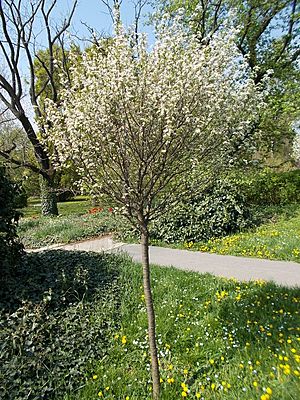Prunus × eminens facts for kids
Quick facts for kids Prunus × eminens |
|
|---|---|
 |
|
| Prunus × eminens 'Umbraculifera' in bloom at the Buda Arboretum in Hungary | |
| Scientific classification | |
| Genus: |
Prunus
|
| Species: |
× eminens
|
| Synonyms | |
|
|
The Prunus × eminens is a small cherry tree. It grows naturally in central Europe. This tree is a mix of two other cherry types: the sour cherry (Prunus cerasus) and the dwarf cherry (Prunus fruticosa). You can find it where these two parent trees grow close together. Like its parents, it has 32 chromosomes. This hybrid cherry is sometimes spreading and mixing with the dwarf cherry. This can make it harder to find pure dwarf cherry trees.
Contents
What Does This Cherry Tree Look Like?
It can be tricky to tell Prunus × eminens apart from the dwarf cherry. This is because they share many features. The Prunus × eminens is a small tree. It usually grows about 3 to 5 meters (10 to 16 feet) tall. Some rare ones can reach 7 meters (23 feet). Its top part, called the crown, is shaped like a ball.
The flowers are white and about 1.5 centimeters (0.6 inches) wide. The fruits are a bright crimson red. The small, oval-shaped leaves turn a beautiful orange color in the fall.
Where Does This Cherry Tree Grow?
Prunus × eminens likes open areas. These are often like wide, grassy plains called steppes. It can also grow at the edges of forests. In the wild, you mostly find it in central Europe. This is where the dwarf cherry also grows. The Prunus × eminens often grows in the same places as the dwarf cherry.
Growing This Cherry Tree
Scientists in Canada have crossed the parent cherry species. They picked the best new trees to create special types. These are sold as Mongolian cherry or dwarf sour cherry.
They even crossed the sour cherry with Prunus × eminens. This created a type called 'SK Carmine Jewel'. Other types like 'Crimson Passion', 'Juliet', and 'Romeo' followed. These cherries can grow in very cold places. They produce fruit even in the northernmost areas where cherries can survive.
These special cherry trees grow in a neat, round shape. They can handle very cold winters, down to USDA Hardiness Zone 4a. Their fruit has a lot of sugar. This makes them great for pies, jams, and jellies.
There is also an ornamental type called Prunus × eminens 'Umbraculifera'. This one has branches that droop a little when it gets older. It is not grown for a lot of fruit. But it makes enough pollen for bees to produce honey.
How We Use This Cherry Tree
Scientists have tested if this cherry can be used as a special root for other Prunus trees. This would make the other trees grow smaller.
The 'Umbraculifera' type is small and round. Its leaves turn bright colors in autumn. It can also handle cold weather. These features make it good for planting along streets. It also grows well in pots and on green roofs. You can find it planted in cities from Sweden to Hungary and Ukraine.
Some plant nurseries graft the round tops of these trees onto other Prunus stems. This makes taller trees that look like lollipops.

